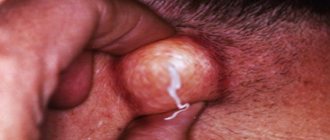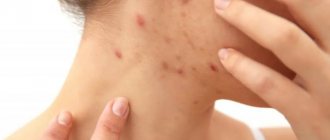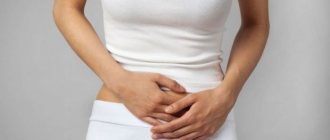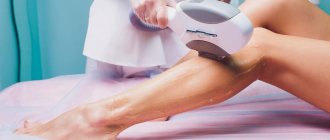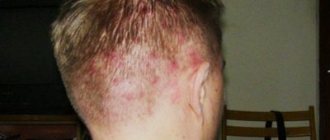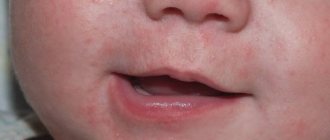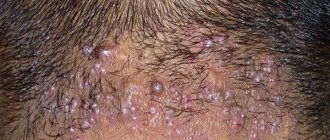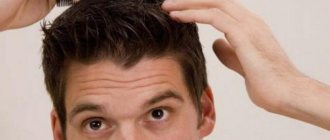Preventive measures
Considering the fact that newborn children have very delicate skin and are susceptible to mechanical damage, allergic, infectious, and microclimatic influences, a very important factor is preventive measures on the part of parents, which will maximally protect the child’s health. To prevent a rash, it is necessary to adhere to the basics aimed at organizing the prevention of such manifestations.
- Compliance with microclimatic conditions. The false idea that warmth for children is the basis of health is often the cause of rashes on the skin: acne, prickly heat and ulcers. In fact, children tolerate a cold environment better than excess heat and moisture, so the optimal temperature in which a child is located is 20-22 degrees.
- Maintaining hygiene rules. Parents should take care of the cleanliness of the baby's skin after feedings (food particles on the chin and cheeks often cause a rash), monitor the secretion of saliva (a frequent phenomenon), and regurgitation. Washing the child after each bowel movement, drying the treated areas with dry wipes, to prevent prickly heat, ensuring free access of air during drying.
- Don't show excesses. In terms of the frequency of bathing a child, the daily norm is considered to be quite enough to complete two procedures, in which the use of soap is not necessary, since detergents remove the protective layer of the newborn’s skin. Wiping away moisture with fabrics or towels is prohibited; you just need to blot all places where moisture accumulates. Excessive use of talc can affect the functioning of the respiratory tract of newborns, so you need to be careful when using the substance when treating areas of the baby’s skin.
- Life Wet cleaning, ventilation and keeping the room clean (especially if there are pets) are an integral procedure for preventive measures against many diseases. The child must be in clean clothes, have a supply of washed and heat-treated diapers and other things.
- Caution against exposure to allergy sufferers. Nursing mothers should know the list of food products that can cause an allergic reaction in newborns and not neglect knowledge to the detriment of the child, using exactly the amount of food ingredients that will benefit both organisms. When processing children's clothes, it is necessary to use detergents that are designed specifically for this purpose.
- Use of vaccines. There are no special drugs for the treatment of viral infections; they usually go away on their own, but the danger of secondary complications can lead to the most disastrous results. Timely vaccination will help develop antibodies in the child’s body that will prevent the development of infectious diseases.
Any manifestations of a rash on a child’s skin are a reason to consult with a specialist to find out the nature of their appearance and possible further treatment with medications prescribed by the pediatrician.
Rash on the face of a baby
A rash on the face of a baby is a fairly common occurrence that horrifies many parents. There can be many reasons for its development. In addition, different reasons can cause different rashes, but they are localized in the same place.
As a rule, rashes localized on the face of a baby are caused by the formation of hormonal levels. In this case, the rash looks like small pimples, mostly red, which spread to the neck and even to the scalp of the baby.
Quite often, at about 2-3 weeks, a newborn develops pimples that have an abscess in the center.
The next most common cause of a rash on the face (cheeks) of a baby may be an allergic reaction. It is especially common in babies who are breastfed. It occurs as a result of the mother’s failure to comply with the diet or when a crumb of a new product is included in the diet. For example, chicken egg white is a fairly strong allergen. That is why pediatricians do not recommend including it in the diet before 1 year, but giving it exclusively boiled yolk. In addition, a nursing woman is simply obliged to refuse to eat foods with red pigment.
Quite often, young mothers, due to lack of sufficient experience, dress the baby too warmly, as a result of which he sweats intensely. Due to the fact that his sweat and sebaceous glands do not work stably, a rash appears, which is localized both on the face and on the baby’s head. In addition, prickly heat is often the result of poor hygiene. Therefore, especially in the hot season, the child should take a bath every day.
In rare cases, the rash may be caused by neonatal infantile pustulosis. This disease occurs in approximately 20% of children. It requires drug treatment. Its peculiarity is that pimples do not have a contaminated pore in the center, and quite rarely fester, so a focus of inflammation does not form around them, which only makes them difficult to detect.
With neonatal cephalitic pustulosis, a change in skin relief is observed, which is quite difficult to distinguish visually. It is detected by palpation. In rare cases, reddish pustules form, which are localized in the neck and face of the child.
Prevention and treatment
Prevention plays a big role in the fight against rashes on the face and head of a baby. Therefore, in order to prevent its occurrence, mother must adhere to the following rules:
- Wash your baby daily with clean boiled water. For such manipulations, you can also use solutions of string and chamomile, which have antiseptic properties.
- Constantly maintain the physical parameters of the air in the room at an optimal level: temperature 18-21, humidity up to 70%.
- Follow a hypoallergenic diet if the child is breastfed.
- If a large area of the face is affected by a rash, you should definitely see a doctor.
- As a rule, if a rash appears in a child, you should not use antihistamines, alcohol solutions (brilliant, calendula), potassium permanganate solution, hormonal ointments, or antibacterial drugs.
Thus, by observing all the above rules, the mother will independently be able to prevent the development of a rash in the child and prevent its spread
It is worth remembering that before using any means, it is important to consult with a dermatologist, who, if necessary, will prescribe competent treatment.
Pustules on the body
The formation of pustules on the body and face of a baby can be a rather alarming symptom and a natural condition that does not require targeted treatment. So, such pimples can appear due to:
- Hormonal fluctuations. When a baby has recently been born, his mother’s hormones are still in his blood, and his own endocrine system is just learning to work correctly. The processes of elimination of maternal hormones may be accompanied by the formation of small pustules and acne. Such acne does not bother the baby at all.
- Toxic erythema. We talked about this state a little higher. If it is generalized, then the baby’s body may become covered with many rashes and pustules. At the same time, the baby’s condition worsens, the rash brings discomfort, and the temperature increases.
- Attacks of various bacteria. When pathological pustules appear, the skin around them appears swollen and red. The blisters can grow and burst, resulting in the formation of ulcers and erosions on the baby’s body. A bacterial rash requires targeted treatment under the supervision of a doctor.
Most often, pustules on the body of infants occur due to natural hormonal processes in the body and go away quite quickly. But only a doctor can accurately determine the cause of their appearance.
Rash on the face and head of a baby, what to do
After examining the child by a specialist and finding out the cause of the rash, the parents’ task is to provide all possible conditions to eliminate the rash on the head, face and other areas of the skin. It is enough to adhere to the basic rules of child care and basic hygiene. During the reception, or at special courses organized locally, specialists must explain in detail the essence of the activities and the technique of their implementation.
- Objects and substances that can cause an allergic reaction in a child should be completely excluded from all types of contact with the newborn.
- Before performing procedures and when communicating with a child, it is necessary to adhere to the rules of personal hygiene: wash your hands as often as possible with plain soap, do not use cosmetics that can cause allergic reactions in the child.
- All household items that the child comes into contact with during play must be constantly treated with hygiene products.
- The bathing procedure should end with careful removal of moisture from all parts of the body by blotting.
- The areas affected by the rash must be treated with medications prescribed by the doctor, according to the instructions for use of the drug.
- When putting things on your child, you should first make sure that they are clean and have been heat-treated after washing.
- Avoid hypothermia and overheating of skin areas.
- Make sure you select the correct items of clothing for walks and active games.
Correct and timely help from parents will help get rid of rashes and prevent their recurrence. Experts recommend using folk remedies to prevent skin irritation and the appearance of rashes by adding a weak solution of potassium permanganate or a decoction of medicinal herbs to the water while bathing. During games and active movements, do not restrict the child’s movements with clothing, ensuring proper air circulation in all parts of the body.
What not to do if a baby has a rash
When a rash appears, parents often repeat the same mistakes, which not only do not help the child get rid of rashes on the head, face and other areas of the skin, but on the contrary, the problem only gets worse. When treating rash-affected areas, the following actions should not be performed:
- Before examining a specialist, do not treat the rash with iodine, brilliant green and other dyes that make diagnosing the disease difficult.
- Violate the integrity of the bubbles.
- Squeeze, pick off pimples.
- Wipe the affected areas with alcohol lotions and hygiene products that are not intended for caring for a child’s skin.
- Interfer with prescriptions prescribed for the treatment of rash by a doctor, replace drugs with others without prior approval from specialists, and refuse to perform procedures.
- Without a preliminary diagnosis of the disease by a pediatrician, begin treatment of the child independently.
Treatment
In the treatment of acne, you should not use drugs that fight pathologies on the facial skin. They will be ineffective, the person will waste his money. The most correct development option would be to contact a dermatologist who can prescribe effective therapy. You should not wait for a purulent pimple to appear; an adult, unlike a teenager, should not be embarrassed by the appearance of a rash on the head and consult a specialist as soon as possible at its first manifestations. Only a doctor can help you get rid of painful pustules or acne in a short time.
If a person does not have the opportunity to see a dermatologist in the near future, he can use several proven treatment methods as therapy.
- Antibacterial ointments help to cope with pathology in the hair on the head. Today, the most popular are Zinc ointment and Salicylic ointment. They help fight various bacterial manifestations and prevent the spread of infection.
- Camphor alcohol and tar are often used to treat the scalp. They are convenient to use if the rash is localized on the back of the head. There is a minimal risk of the product getting into your eyes. Camphor and tar have an exfoliating and antibacterial effect.
- With prolonged development of pathology, dermatologists may prescribe antibiotics. As a rule, they are used for extensive acne on the scalp in the hair. The drugs Ofloxacin, Doxycycline, Ceftriaxone help get rid of acne.
- Sorbents are also necessary to rid the body of harmful substances that have accumulated over time. Perhaps they are the reason that a person develops acne. Medicines such as White Coal, Enterosgel, Smecta will help.
- Dermatologists recommend using lactobacilli in combination. These may not even be special preparations, but homemade yogurt on a natural basis. They help improve the condition of the intestines, the work of which, in turn, affects the condition of the scalp and hair.
We must not forget that therapy aimed at removing acne must be comprehensive. Ideally, the patient should take all types of drugs that have an antibacterial, anti-inflammatory, drying and sorbing effect.
Why is the manifestation of furunculosis on the head dangerous?
Manifestations of furunculosis on the head are considered the most severe and dangerous, since with an unfavorable development of the disease, necrotic phlegnoma can develop, in which pus can penetrate into the facial vein cava and lead to inflammation of the meninges, i.e. – meningitis.
The most dangerous thing is to treat furunculosis on your own, primarily by trying to open or squeeze them out. This is what most often leads to the spread of pus, and with it inflammation.
Therefore, if characteristic signs of furunculosis appear on the head, neck, or especially the face, you need to consult a surgeon. The doctor will examine the rashes and, depending on their location and size, will decide on the further course of therapy.
In mild cases, you can do without surgery by using local and systemic antibiotics, antibacterial and stretching ointments, as well as other conservative agents.
If further development of a boil on the head poses a potential danger to the patient's health, it should be opened and cleaned in a sterile hospital environment.
The operation is performed under local anesthesia. The doctor makes a small incision through which the pus is released, and most importantly, the purulent core is removed, after which he rinses the cavity with antiseptic and bactericidal solutions and applies sutures. The operation is quick and in most cases healing occurs without complications.
What types are there
In a one-month-old baby and an older baby, the clinical picture is different, which depends on the type of rash. The main types of acne on the face and head are presented in table form:
| View | Short description |
| White | They are small in size and resemble a small grain |
| Localized under the upper layer of the epidermis | |
| Are a consequence of blockage of the sebaceous gland | |
| More often recorded in children during adolescence | |
| Reds | Nearby skin also turns red |
| If an inflammatory process occurs, the pimples become filled with pus. | |
| Blackhead | Located near the epidermis |
| Rarely cause itching and other unpleasant symptoms | |
| Large pimple with purulent fluid | Always accompanied by pain |
| In advanced cases, the child may have hair coming out on his head. |
Why do acne appear on the scalp?
Acne can appear for completely different reasons, which will be in the nature of an external or internal factor. The disease can occur in any person, regardless of gender and age.
Dermatologists today identify several reasons leading to the development of acne on the head:
- Overactivity of the sebaceous glands. When they function excessively, a person’s scalp pores become clogged. Particularly susceptible areas are those where there is hair. Hair grows from a follicle, which can become inflamed due to overactive glands.
- Hormonal disbalance. Here it is worth distinguishing between endocrine disorders in women and men. Since in the first, acne on the head may appear as a result of menstrual irregularities during pregnancy. In the second, there is a sharp decline in testosterone levels.
- Violation of personal hygiene. According to the advice of cosmetologists and dermatologists, it is recommended to wash your hair at least once a week, unless a person experiences daily physical activity that leads to increased sweating. If you have a job that requires physical activity, you should keep your hair clean 3 times a week.
- Improper scalp care. The rule that hair must be washed every day or every other day is considered incorrect. This disrupts the natural production of sebaceous glands, which are designed to protect the head from dryness. Since the natural fat layer is removed, the glands begin to work harder, which leads to their hyperactivity.
- Wrong selection of shampoo. Even this factor can cause the development of acne on the head. If the hair washing product is chosen incorrectly, it can cause irritation of the skin, lead to dryness or, on the contrary, excessive oily deposits. You need to know your hair type to make the right choice of shampoo.
Skin microtraumas often cause acne to appear. It is possible to injure the scalp even with a comb or by constantly scratching the skin with nails. This phenomenon is not uncommon when dandruff appears. It begins to cause severe itching and as a result of constant microtrauma, acne appears.
Bad habits such as consuming nicotine and alcohol can lead to acne on the scalp. Constant stress and overexertion affect the well-being of the entire body, including the condition of the hair and scalp. The reason that a rash appears may be wearing a tight headdress. It creates minor mechanical friction, which leads to skin irritation. Acne is sometimes the body's reaction to an allergenic product eaten or a hat that was washed with low-quality powder. Due to allergies, a rash appears on the skin. With prolonged treatment, it can develop into pustular formations. Taking steroids. Colds and hypothermia affect the condition of the skin. When a person eats excessive amounts of sweets, he may develop acne
Fast-burning carbohydrates often lead to dysfunction of the skin. Disturbance in the functioning of the adrenal glands. It is worth paying attention to the bedding that a person uses. If it is made of synthetic material, this may well be the reason; A skin rash often occurs as a result of a malfunction of the intestines.
Therefore, it is worth trying to carefully consider your diet. Perhaps there is a lot of junk food, which doubles the work of the organ. Seborrheic dermatitis of the scalp.
How to deal with acne on a baby's head?
Follow a gentle cleansing routine for your baby's scalp
By following basic home instructions, parents can minimize the appearance of scalp acne in babies.
- You should wash and dry your child’s hair with a very mild shampoo, which is classified as a children’s type of shampoo;
- Be careful not to rub your delicate scalp too vigorously.
- Some doctors also recommend using plain white yogurt. Rub the yogurt in the bath without rinsing off the yogurt for about 5 minutes, then gently rub it with a towel, helping to clear the rash and moisturize the scalp.
What to avoid
Don't treat acne and scalp pimples in children the same way as you do in adults or teenagers.
- Don't try to squeeze pimples.
- Do not use medicinal solutions that are intended to treat acne, such as salicylic acid or benzoyl peroxide.
- Do not use astringents.
- Avoid using oily lotions on your baby's skin. Oily lotions can make your baby's acne worse.
The most important thing for a mother is to be calm and patient. Children's acne most often does not bother the child with pain or other unpleasant sensations; try not to let this bother you, because most often acne in babies goes away on their own within 2 - 3 months without the need for special treatment, which can often only worsen the disease!
Advice from Dr. Komarovsky
As we have already said, no special treatment is required for acne in a newborn, but there are some nuances that Evgeniy Olegovich recommends that all young mothers learn and learn.
- Squeezing pimples on a baby is strictly prohibited! Firstly, it hurts, and secondly, pathogenic bacteria can get into the wounds and cause an inflammatory process. Then, in place of such “complicated” wounds, ugly scars will remain, which are no longer possible to get rid of.
- If parents use cosmetics for children, they should be labeled “From the first days of life.” There is no need to burn acne with brilliant green, iodine, alcohol or alcohol-containing solutions. Antibiotic ointments are also prohibited. and even regular baby cream, because it’s quite greasy. Don't try to solve the problem with powder, it's useless. If there are a lot of rashes, you can use zinc ointment or Sudocrem; they effectively “dry out” the pimples.
- If the acne does not go away for a long time, the rash becomes larger and more and more areas of the baby’s face are covered with it, be sure to consult a doctor. Such pimples may not have a hormonal root cause, but an infectious one.
- A mother who is breastfeeding should worry less so that the stress hormone cortisol does not enter the milk. It also contributes to the appearance of skin problems in the child. In addition, a nursing mother should reconsider her diet.
- A child with newborn acne needs sun and air baths and hardening. In the warm season, a baby with problem skin should be outdoors more often. Phytotherapy is acceptable - bathing in water with the addition of a decoction of chamomile and string. You can wash your baby with chamomile several times a day, avoiding getting the decoction in the eyes, nose and ears.
- With the right approach, according to Evgeniy Komarovsky, acne goes away without a trace on its own in a fairly short time - from several weeks to 3 months.
Autoimmune diseases: causes and methods of treatment
For healthy people, patients with psoriasis or scleroderma do not pose any threat; these diseases are associated with a deficiency of essential vitamins and minerals in the body. The patient must be protected from situations that cause depression, anxiety and stress, after which the doctor prescribes oral drug treatment, namely:
- take a course of medications with a high content of vitamins, amino acids and minerals necessary for the recovery of the body;
- sedatives (if the patient is unable to get rid of stress on his own).
Rashes in a newborn baby
As a rule, in the first weeks of their child’s life, parents encounter the following types of rashes on their child’s skin:
- Acne of newborns. These are inconspicuous white pimples, the appearance of which is physiological in nature. According to statistics, a third of children experience such rashes in the first weeks and months after birth. As a rule, white pimples that appear on the face, scalp and neck of a newborn do not require any special treatment or medication. Since they do not have a comedon - a clogged pore, under normal conditions they practically do not become inflamed and do not fester.
note
According to experts, the cause of this kind of acne is an excess of maternal hormones in the baby’s body. As soon as the child’s hormonal levels return to normal (on average 1-3 months), the acne will disappear on its own. During the period of hormonal rashes, parents are required to do only one thing - keep the baby’s skin dry and clean.
- Acne covering large areas of the skin. This type of rash can be identified by the red base and white tip of the pimples. Whitish-yellow pus accumulates under the skin. As a rule, acne appears a week after birth and can remain on the skin for almost a month. This problem arises due to the active functioning of the glands. If the rashes do not cause discomfort to the baby (they do not itch or itch), and no inflammatory processes are observed, then parents do not need to worry about them, everything will go away and not a single trace will remain.
- Milia is another type of rash that is quite common in newborn babies. As a result of the accumulation of secretions in the sebaceous glands, or in other words, blockage of the sebaceous ducts, small white dots appear on the baby’s face, which eventually disappear on their own without any treatment. These pimples should not be squeezed or picked off, as this can cause infection and thereby provoke an inflammatory process.
All of the above types of rashes are typical only for newborn babies; they are not contagious and, subject to certain hygiene rules, go away on their own without drug treatment.
Pustular infections in children
A serious attitude towards child hygiene is the key to avoiding many health problems. This also applies to skin diseases - dermatitis , which has a large number of varieties. The most common of them in children (especially newborns) are pyoderma. Pyoderma is a purulent skin lesion. It is a group of diseases that are caused by pyogenic microorganisms when they penetrate the skin. It is important for parents to know how pyoderma is transmitted: it occurs through direct contact with a sick person and contaminated objects.
The disease occurs most often in children (especially newborns) and has many varieties. It is believed that pyoderma occurs mainly due to poor nutrition and poor child care. However, this is not always the case. This skin disease is caused by various pathogens: streptococci, staphylococci, pneumococci, Pseudomonas aeruginosa, E. coli and others. Often, some microorganisms live peacefully in the human body and do not make themselves felt. But as soon as for some reason the body’s protective functions decrease and the gates to infection “open,” they begin to manifest their pathogenic properties.
Since it is newborns and infants who have the weakest protective mechanisms, pyoderma occurs in them quite often with a severe course, especially with untimely treatment and improper care. Children under 2 months are not able to produce antibodies on their own. Therefore, it is very important in the first days of a baby’s life to especially carefully monitor the care of the skin of the entire body. Ideal conditions for the development of pyoderma are fumes under oilcloth diapers, sweat, saliva, urine, nasal discharge, which are not cleaned out in a timely manner, because infants have a thin and loose stratum corneum of the skin, which is easy to infect with pathogens. Hypothermia and overheating of the body can also cause purulent skin disease. They provoke pyoderma and itchy dermatoses: eczema, urticaria, scabies, neurodermatitis, etc.
Other causes of pyoderma include:
- insect bites;
- diseases of internal organs and nervous system disorders;
- immunodeficiency;
- lack of protein in the diet.
How to identify pyoderma?
It is impossible not to notice it on a child’s skin. It all starts with small areas of redness, which over time become covered with small blisters filled with pus. After the bubbles “burst,” the contents flow out and in their place, on the skin, dry crusts form. Usually there are no traces of fallen crusts left. However, if the cause of the appearance of pustules is not eliminated and they are not treated, then boils may appear on the child’s body; in the worst case, an abscess and phlegmon may occur. As a result, a number of complications arise and the child’s general condition worsens. In extremely severe cases, sepsis can develop - a general infection of the body.
Pustular skin diseases manifest themselves in different ways. Everything depends on the pathogen, on the depth of the skin lesion, on the course of the disease itself, on the individual properties of the body, on the state of the immune system, and so on.
Forms of pyoderma that occur in childhood
Vesiculopustulosis (periporitis). Develops most often in infants. Periporitis is preceded by prickly heat, which is caused by overheating. Vesiculopustulosis is accompanied by multiple rashes (transparent blisters) on the body, in the folds, and on the scalp. With proper care, the rashes disappear after a few days. Vesiculopustulosis refers to staphylococcal pyoderma.
Streptococcal impetigo. Develops as a result of scratching with itchy rashes (insect bites, scabies, atopic dermatitis, purulent otitis media). It is characterized by the appearance on the face of pustules with purulent contents, which form into crusts and fall off, leaving unstable pink spots and small scars. Observed in children of the first year of life
Slit-like impetigo. Bubbles form in the corners of the mouth, at the outer corners of the eyes, and at the wings of the nose. They open very quickly, leaving behind painful cracks. The disease is often chronic, especially in the presence of carious teeth, conjunctivitis, rhinitis, hypovitaminosis B2 and B6.
Pseudofurunculosis. The purulent process develops in the thickness of the skin, in the ducts of the eccrine sweat glands. Relapses are common. The rash appears in the form of small nodes with soft tissue swelling. This disease is accompanied by a disturbance in the general condition of the child: body temperature rises, appetite worsens, body weight decreases, and dyspepsia appears.
Pyococcal pemphigoid (epidemic pemphigus of newborns). Characterized by superficial purulent skin lesions. The rash appears in the form of small blisters, which do not form a crust after bursting. Appear on the abdomen and limbs, less often on the mucous membranes. Sometimes septicopyemia (sepsis) may subsequently develop.
Ritter's exfoliative dermatitis. This disease is considered a malignant type of pyococcal pemphigoid. It appears already in the first week of a child’s life and is the most severe disease caused by staphylococcus. The rashes that accompany the course of the disease resemble wounds from second-degree burns and affect the entire body of the child. The course of the disease has a number of complications, in 50% there is death. The disease is associated with the penetration of phage group 2 staphylococcus into the body of a newborn. This microorganism produces a special toxin, which provokes detachment of the epidermis.
This is not a complete list of forms of pyoderma in children. If you suspect this disease, you should immediately consult a doctor. Timely treatment can reduce a number of complications.
Treatment of pyoderma is carried out externally or systemically, depending on the form and type of the disease. However, it is important to adhere to 3 rules:
- Do not wet the affected areas of the skin.
- Trim hair in areas of rashes.
- Maintain child hygiene.
For pyoderma in newborns, treatment, on the contrary, involves regular baths with the addition of potassium permanganate. To detect the pathogen, a bacteriological culture is performed. If the area of the rash is small and the pustules are weakly expressed, antibacterial and antifungal ointments, creams, and antiseptic solutions (potassium permanganate, brilliant green) are used externally.
In case of extensive rashes and deterioration of the child’s well-being, antibacterial therapy is prescribed. To strengthen the immune system, multivitamins are prescribed.
Treatment with folk remedies in the form of compresses with aloe juices, potatoes, yarrow decoctions, burdock root, Vaseline ointment and crushed celery leaves is used for mild forms of pyoderma.
Lastly, always remember to take preventive measures. Careful care, good nutrition, adherence to personal hygiene rules, careful attention to the treatment of common diseases, immediate treatment of emerging microtraumas - this is what can protect your children from an unpleasant disease.
Deputy Chief Physician
in medicine Elena Ivanovna Rakovskaya
Why do babies get pimples on their head?
Rash on various parts of the body in infants is a common occurrence. It is much less common to see a baby whose skin is perfectly smooth from the first days of birth. Rashes on a newborn’s head are often a simple reaction to some kind of irritation.
Skin Features
Human skin consists of subcutaneous fat, dermis and epidermis. The epidermis consists of 12-15 rows of the stratum corneum. The stratum corneum is the topmost layer; it is the one in contact with the external environment.
It consists of scales that are closely adjacent to each other, creating skin protection. The structure of the skin of an adult differs from that of a child in the degree of formation of the layers. 70% of children's skin consists of water, it has an increased blood supply, but a thin stratum corneum.
Therefore, a newborn easily becomes hypothermic and overheated if the temperature in the room is not monitored.
Causes and treatment
- One cause, hormonal rash (neonatal), occurs due to maternal hormones that are passed on to the baby during pregnancy.
Appears on the scalp and face at 1-3 weeks of a child’s life. The rash may be pink or red and is not cause for concern. Doctors do not consider hormonal rash a disease. Usually all symptoms disappear by 2 months. - Food allergies.
If allergenic foods are present in the diet of a nursing mother, then diathesis appears in infants. The rash covers the child's entire body. An incorrectly selected formula for feeding can also cause an allergic reaction. Soaps containing chemical dyes and fragrances also cause irritation. Typically, an allergic rash causes itching, and the child will behave restlessly. Once the allergen is identified and removed from the diet, the rash will disappear. - Dysbacteriosis.
When the balance of the intestinal flora is disturbed, the child suffers from diarrhea, flatulence, bloating, and all this is accompanied by allergic dermatitis. Pimples in babies appear on the face and scalp. Treatment is prescribed in a complex, two-stage manner. The first will use bacteriophages, the second will use bifidobacteria. - Reaction to changes in air temperature. Sometimes the temperature contrast from warm to cold causes acne to appear on a child's skin.
- Prickly heat.
Appears in the hot season due to improper child care. In this case, pimples in infants are located on the back of the neck, on the head and skin folds of the arms and legs. Small rashes are pink in color. Miliaria does not require special treatment; it is enough to simply bathe your baby more often and prevent him from overheating.
To treat pimples in children, you cannot use products intended for adults.
Prevention and care
Observe basic hygiene standards. Wash your hands thoroughly before touching your baby.
If your baby is prone to skin irritations, try to use diapers less often. Pimples on the butt often appear due to wearing diapers for a long time. To allow your skin to breathe, take air baths in a warm room. Maintain a constant temperature in the children's room, no higher than 20 °C.
The child should be bathed in boiled water with the addition of chamomile, string, and sage. Bed linen and children's linen must be washed with hypoallergenic detergents. Be sure to iron with a hot iron. Baby clothes should be made from natural materials.
Under no circumstances should you open up pimples on a newborn’s head.
Symptoms that should alert parents:
- Rashes in the form of pink watery spots, cervical lymph nodes are enlarged - this could be rubella.
- Fever, runny nose, pimples on the head, face, and behind the ears are symptoms of measles.
- Small rashes in the armpits, on the arms, vomiting, and fever can be signs of scarlet fever.
- The areas of the back, buttocks and legs become covered with blisters that burst and form erosion - these are symptoms of diaper dermatitis.
- Pemphigus of newborns is characterized by the formation of blisters with clear liquid inside. The child becomes lethargic, loses his appetite, and may have a fever.
In these cases, it is necessary to seek medical help.
What causes pimples on a baby's head and what do they look like?
About one-fifth of all newborns and infants are likely to develop baby acne. This is consistent with research conducted at the Children's Hospital of Philadelphia. Baby acne is also called neonatal acne. The appearance of acne on the scalp of babies is more common in boys than in girls.
The reason for the appearance of acne in a child is explained by the presence of maternal hormones from pregnancy at certain stages in the first months of the baby's life. Pimples in addition to the head can also appear on the neck, head or face of the child, the presence of which can last from three to four months. Of course, there may be other reasons, causing acne on the head, which we will discuss in detail in the article below.
When to see a doctor
- If acne appears after a year, this is a very good reason to contact a pediatrician, and then an allergist and dermatologist.
- If a child with a severe acne rash loses his appetite, his behavior and sleep are disturbed, his skin becomes dry and rough, this is also a reason to undergo a thorough examination by specialists.
- If the origin of the rash cannot be determined. If you can’t figure out whether she’s allergic or physiologically infantile, Komarovsky advises visiting a doctor. A specialist will be able to quickly resolve all issues and give the necessary recommendations.
What's new in the "Komarovsky" section
Top 5 acne shampoos for the head
You can try using specialized anti-acne shampoos in complex therapy. Many of them are better known as a remedy for dandruff, but in fact they can also fight minor rashes on the scalp. Today in the pharmacy you can find a wide range of such products; based on reviews from buyers and consumers, we can conclude that the following shampoos are more popular:
- Sulsena. Helps prevent and eliminate acne on the scalp. Selenium disulfide, the active component, is able to kill bacteria and control the process of sebum secretion. It has low cost. Negative reviews only indicate the presence of a specific aroma, but the shampoo does its job perfectly. The rash disappears within 2 weeks (without the use of medications in combination).
- Nizoral. Contains an antifungal component that helps cope with acne caused by a bacterial infection. At the initial stage, when comedones just begin to appear, the shampoo is highly effective. But it is worth remembering that the remedy will give results only if the pathology has a fungal etiology.
- Sebozol. This is an analogue of Nizoral. Contains the active component Ketaconazole, which kills fungal infections. It can be used for seborrhea, psoriasis and rashes of various origins.
- Skin Cap. It is used for acne that appears on the scalp due to an allergic reaction. Has anti-inflammatory and anti-allergic effects. It is often prescribed by cosmetologists for problematic skin rashes.
- Tar 911. Has many positive reviews as a remedy for eliminating a specific rash on the head. The shampoo regulates the secretion of sebum and prevents the further spread of pathogenic microflora due to birch tar, which is included in the product. It is highly effective against dandruff, acne, and dermatitis.
Sources
- https://muzhskie-gormony.info/pryshchi-na-golove-v-volosah-u-muzhchin-prichiny-lechenie/
- https://vseokozhe.com/pryshhi/na-golove/pochemu.html
- https://zdorov.online/articles/pryshchi-na-golove-u-rebenka/
- https://pervenets.com/zdorove/bolezni_lechenie/prichiny-poyavleniya-gnojnichkov-na-golove-u-rebenka.html
- https://StopRodinkam.ru/pr/lc/pryshhi-na-golove-u-rebenka.html
- https://furunkul.com/prishi/na-golove-v-volosah-u-vzroslogo.html
Folk remedies and recipes
- To cleanse the scalp, wipe it with strawberry juice.
- Add 2 tablespoons of calendula tincture to a glass of water. Soak a cotton pad with the product and wipe the affected areas.
- Make a hair mask from 2 tablespoons of olive oil and lemon juice. Apply to the head and keep, wrapped in polyethylene, for 1 hour. Rinse off with warm water using shampoo.
- Pour 100 g of anise seed with water overnight. Grind the seeds and apply the resulting paste to your hair. Cover with film and leave for an hour. Rinse off with warm water. It is recommended to make this mask every other day for 2 weeks.
- Apply lotions from dandelion decoction to the affected areas.
- After each hair wash, rinse your hair with infusions of yarrow, chamomile, string, and sage herbs.
- You can prepare shampoo at home. Make a paste of 2 tablespoons of colorless henna and water. Beat 1 egg into it and mix thoroughly. Apply to hair, massaging skin. Rinse well with warm water.
Attention! Before using traditional methods of treatment, consultation with a dermatologist is required. You can also find out everything about acne on other parts of the body and methods of treating it on our website
For example, about acne on the back is written here, about a pimple on the lip in this article, about subcutaneous acne on this page, about acne on the forehead at this address, and here you can read about how to remove the redness of acne
You can also find out everything about acne on other parts of the body and methods of treating it on our website. For example, about acne on the back is written here, about a pimple on the lip in this article, about subcutaneous acne on this page, about acne on the forehead at this address, and here you can read about how to remove the redness of acne.
